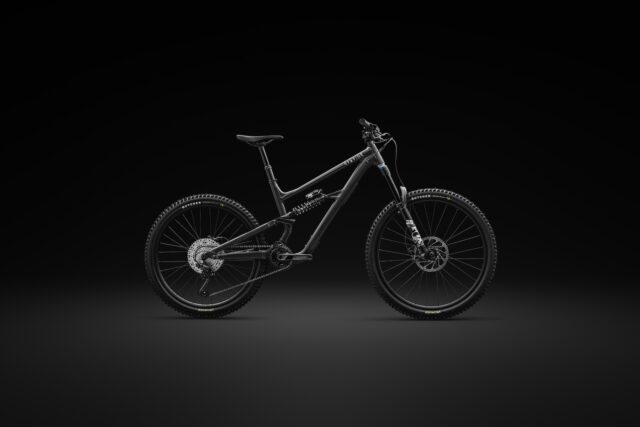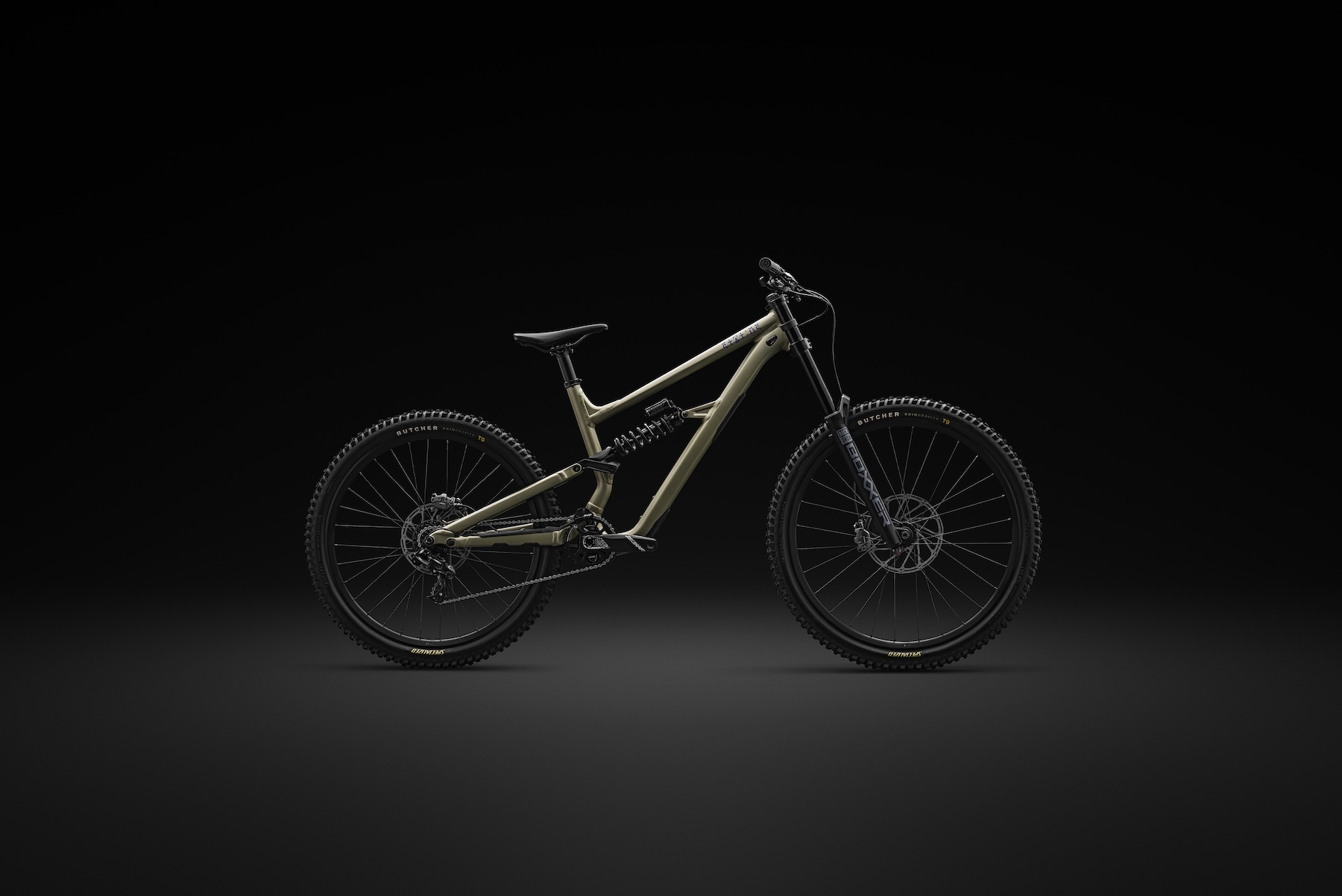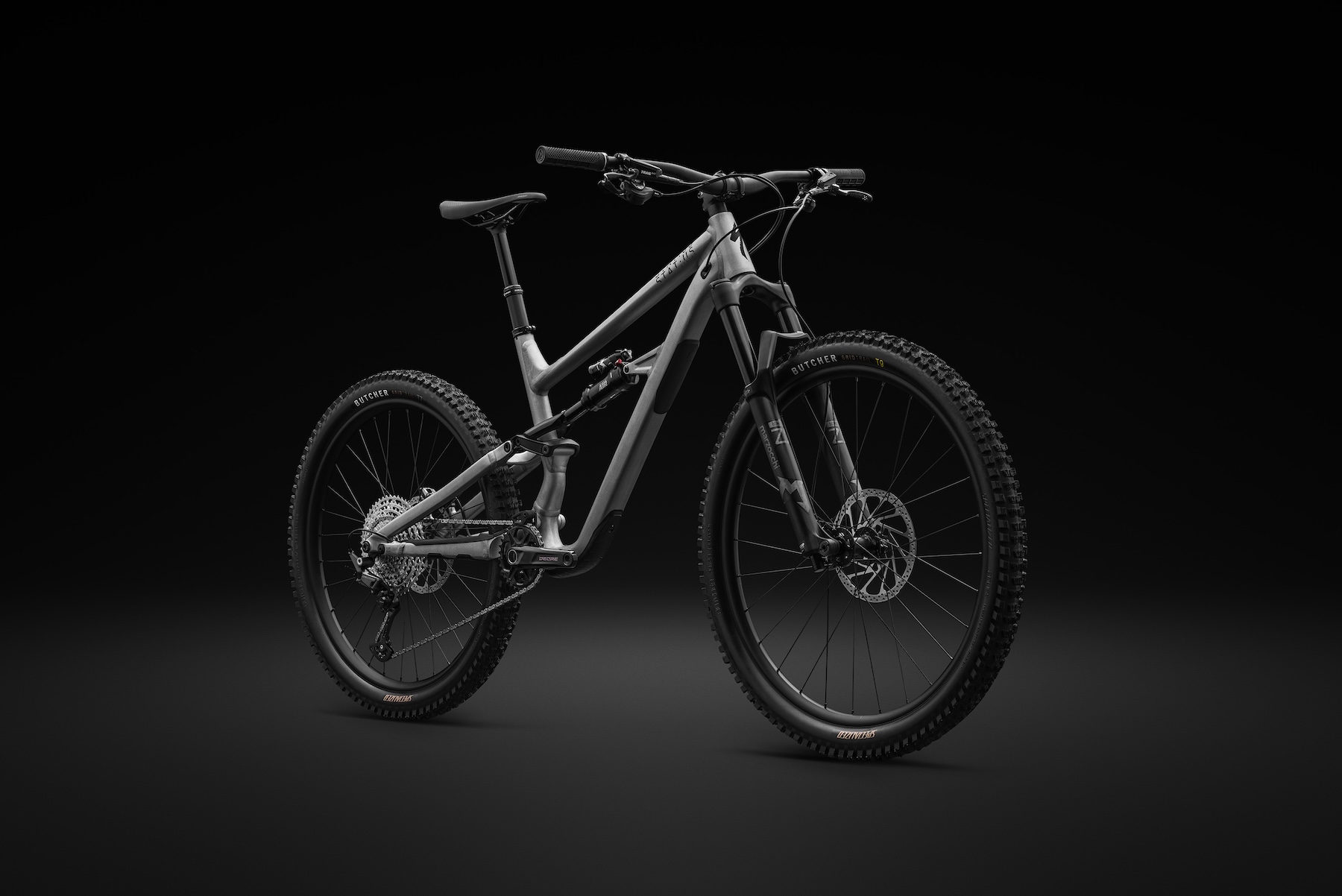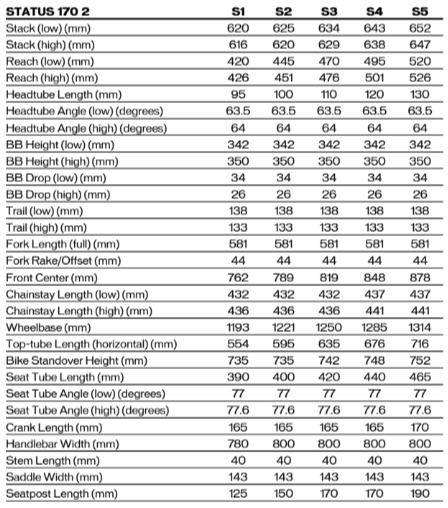Wheel Size: 29’’ front / 27.5’’ rear (sizes S1–S5); 27.5’’ front / 26’’ rear (S0)
Travel: 140 mm front / 140 mm rear
Geometry Highlights:
- Sizes Offered: S0, S1, S2, S3, S4, S5
- Headtube Angle: 64° (Low), 64.5° (High)
- Reach: 465 mm (Low), 471 mm (High) (size S3)
- Chainstay Length: 427 mm (Low), 431 mm (High) (size S3)
Frame Material: Aluminum
Price: Complete bikes starting at $3,000 USD
Wheel Size: 29’’ front / 27.5’’ rear (sizes S1–S5); 27.5’’ front / 26’’ rear (S0)
Travel: 170 mm front / 170 mm rear (DH version gets 180 mm front)
Geometry Highlights:
- Sizes Offered: S0, S1, S2, S3, S4, S5
- Headtube Angle: 63.5° (Low), 64° (High)
- Reach: 470 mm (Low), 476 mm (High) (size S3)
- Chainstay Length: 432 mm (Low), 436 mm (High) (size S3)
Frame Material: Aluminum
Price:
- Complete bikes starting at $3,000 USD
- Frameset: $2,000 USD

Intro
Despite oddly covert marketing tactics, the Specialized Status has been a popular bike with riders on a budget who skew toward the gravity-fed side of the sport. With a dedicated mixed-wheel setup, the outgoing model prioritized fun over all-out speed, with short chainstays and a freeride-influenced demeanor. Though it looks similar, the new Status 2 features an all-new frame, adjustable geometry, options for both 140 mm and 170 mm of travel, a dual crown DH build, S0 sizing for riders under 5’ (152 cm) tall, and more. Check out our introduction to the new Status 2 for a rundown of all the big updates.

The Frame
Like the prior Status, the Status 2 comes in two different travel options — the same 140 mm for the shorter-travel variant, and a 170 mm version that gets a 10 mm boost in travel over the outgoing Status 160. Though Specialized offers these two different options, both share the same frame construction and features. The new Status 2 is an aluminum-only affair, made from Specialized’s M5 alloy and featuring a mixed wheel setup across the board. All frames get two-position flip chips at the lower chainstay pivot, allowing riders to swap between the stock High geometry mode or shift into Low for a slacker head angle and lower bottom bracket.

The rear suspension layout is virtually identical to the prior version, with a yoke-driven shock and a four-bar Horst Link layout. Specialized specifically calls out the focus on simplicity with the Status 2, and the straightforward frame design and features speak to that ethos. Specialized doesn’t provide kinematics charts for the Status 2, but we’d expect a fairly progressive leverage rate given the emphasis on playful, Freeride-inspired riding.
We’ll dig into the specifics more in the geometry section below, but a big update here is Specialized’s inclusion of an S0 size for both the Status 140 2 and Status 170 2. Designed specifically for riders under 5’ tall, the S0 size still gets mixed wheels, but with a 27.5’’ wheel up front and 26’’ wheel out back. S0 and S1 frame sizes in both travel options get a 2.5 mm shorter stroke shock, implying a higher leverage ratio better suited for lighter-weight riders.
As seen with the Status 170 2 DH build, the Status 170 2 is dual crown ready, with the Status 170 2 DH getting a 180 mm RockShox Boxxer fork.

Fit & Geometry
Status 140 2
Despite sharing frame details, things start to diverge between the 140 mm and 170 mm options when it comes to geometry. Starting with the shorter travel option, the Status 2 140 gets Specialized’s familiar S-sizing, with the inclusion of the S0 size in addition to S1–S5 sizes. In the middle of the size range, our S3 reference point in the High position gets a 471 mm reach paired with a rather low 614 mm stack height and 64.5° headtube angle. That’s a steeper head angle than the prior Status, which is likely a good thing in that it seems a bit more versatile and well-matched to the bike’s playful intention. Unlike the old Status, the Status 2 gets scaling chainstay lengths across the size range, with sizes S0–S3 getting 431 mm chainstays in the High position while S4 and S5 frames get a 5 mm boost to 436 mm.

In the case of all of those figures, adjusting between the stock High setting to Low makes a small, but noticeable difference. In the case of the S3, the reach shrinks to 465 mm, the stack grows to 618 mm, the headtube angle drops to 64°, the bottom bracket height drops by 8 mm, and chainstays shrink to 427 mm.
The seat tube angle has been steepened by a full degree with the new Status 2, sitting at 77° in Low or 77.6° in High. Full geometry figures for all sizes, including the new S0 size, are included below:


Status 170 2
The geometry figures look a bit different for the longer-travel Status 170 2, but only modestly. As one might expect, the longer-travel Status 170 2 gets slightly more aggressive geometry compared to its shorter travel sibling, with a 64° headtube angle in High and 63.5° headtube angle in Low. The S3 size gets a 476 mm reach, 436 mm chainstays, and a taller 629 mm stack in the High position, with the Low position cutting reach to 470 mm, chainstay length to 432 mm, and bumping stack up to 634 mm. As with the Status 140 2, the Status 170 2 gets 5 mm longer chainstays on sizes S4 and S5 at 441 mm in High and 437 mm in Low. Where the outgoing Status 160 had very short 425 mm chainstays paired with a very slack headtube angle that reached as low as 63.2° in Low, the new Status 2 should offer a bit more balance between front and rear proportions.
Park riders will be thrilled to see that Status 170 2 comes in a DH option, equipped with a dual crown 180 mm Boxxer fork. While that’s 10 mm more travel than the 170 mm single crown on the regular Status 170 2, geometry figures remain the same due to the lower axle-to-crown height of the dual crown fork at a given travel amount. The Status 170 2 DH is only available in S2–S5 sizes.
Full geometry figures for all sizes, including the new S0 size, are included below:



The Builds
Despite differences in geometry across the Status 140 2 and Status 170 2, the build specs look quite similar between models. There are five builds available across the Status 2 range, but two of those builds are specific to the S0 sizes of the Status 140 2 and Status 170 2. That means the Status 140 2 is available in one build for sizes S1–S5, while the Status 170 2 gets the standard single crown build as well as the DH build option.
Specialized mentions prioritizing suspension and brakes across the builds, and it’s great to see 4-piston brakes with big rotors on everything from the DH model all the way down to the S0 models for smaller riders. The S0 builds are full SRAM affairs in terms of drivetrain parts, with suspension provided by Marzocchi and Fox. The builds on S1–S5 sizes for the Status 140 2 and Status 170 2 both get Shimano Deore M6100 drivetrains and TRP Trail EVO brakes, with the Status 140 2 getting Marzocchi suspension while the Status 170 2 gets a Fox 38 and coil DHX shock. The Status 170 2 DH is an all-SRAM affair, with RockShox suspension and SRAM drivetrain and brakes.


All of the Status 2 models also share alloy wheelsets from Specialized, and all but the Status 170 2 DH get dropper posts from X-Fusion at size-specific drop intervals. Burly parts across the board mean that none of the models are particularly lightweight, but the focus on durability is likely a good call given the target rider type for the Status range. The specs are well-considered in many respects, but the bikes don’t stand out super strongly in terms of value, especially when compared to many of the European direct-to-consumer brands.
Highlights from each model’s available builds are as follows:
- Drivetrain: SRAM NX Eagle
- Brakes: SRAM Code R (w/ 200 mm front rotor, 180 mm rear)
- Fork: Marzocchi Z1 (140 mm)
- Shock: Marzocchi Bomber Air
- Wheels: Specialized Traverse alloy rims w/ sealed cartridge bearing hubs
- Dropper Post: X-Fusion Manic (100 mm)
- Drivetrain: SRAM NX Eagle
- Brakes: SRAM Code R (w/ 200 mm front rotor, 180 mm rear)
- Fork: Fox 36 Rhythm (170 mm)
- Shock: Fox Float X Performance
- Wheels: Specialized Traverse alloy rims w/ sealed cartridge bearing hubs
- Dropper Post: X-Fusion Manic (100 mm)
- Drivetrain: Shimano Deore M6100
- Brakes: TRP Trail EVO (w/ 203 mm rotors)
- Fork: Marzocchi Z1 (140 mm)
- Shock: Marzocchi Bomber Air
- Wheels: Specialized Alloy w/ sealed cartridge bearing hubs
- Dropper Post: X-Fusion Manic (S1: 125 mm, S2: 150 mm, S3–S4: 170 mm, S5: 190 mm)
- Drivetrain: Shimano Deore M6100
- Brakes: TRP Trail EVO (w/ 203 mm rotors)
- Fork: Fox 38 Rhythm (170 mm)
- Shock: Fox DHX Performance
- Wheels: Specialized Alloy w/ sealed cartridge bearing hubs
- Dropper Post: X-Fusion Manic (S1: 125 mm, S2: 150 mm, S3–S4: 170 mm, S5: 190 mm)
- Drivetrain: SRAM GX DH
- Brakes: SRAM Maven Bronze (w/ 220 mm front rotor, 200 mm rear rotor)
- Fork: RockShox Boxxer Select RC (180 mm)
- Shock: RockShox Super Deluxe Select Coil
- Wheels: Roval Alloy DH w/ sealed cartridge bearing hubs
- Dropper Post: N/A
In addition to the complete builds, Specialized also offers a Status 170 2 frameset. At $2,000 USD, the frameset includes a DHX Performance coil shock.
Some Questions / Things We’re Curious About
(1) It’s unusual to see brands steepening headtube angles on newer bikes, but does the steeper headtube and slightly longer chainstay configuration give the Status 2 more balanced handling?
(2) Where does the Status 2’s suspension fall in terms of efficiency versus forgiveness, and can it accommodate a wide range of riding styles?
(3) Given the significant overlap in build spec, just how different do the Status 140 2 and Status 170 2 feel on the trail?
Bottom Line (For Now)
Specialized’s continued investment in the Status platform seems to have yielded some compelling changes in the Status 2. At their current asking prices, all models of the Status 2 seem to occupy an interesting middle ground between entry-level builds and more expensive options, but the blend of burly parts and a simple frame platform could make for a very appealing option for riders who want a dependable ride for more spirited and playful riding. The inclusion of the S0 frame size should also pose a great opportunity for small (or young) riders to level up into a capable platform with a solid build spec, too.

Hey status 2 170 in high position have 4mm shorter chainstay, 428 um high 432 in low position